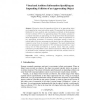Free Online Productivity Tools
i2Speak
i2Symbol
i2OCR
iTex2Img
iWeb2Print
iWeb2Shot
i2Type
iPdf2Split
iPdf2Merge
i2Bopomofo
i2Arabic
i2Style
i2Image
i2PDF
iLatex2Rtf
Sci2ools
HCI
2007
2007
Visual and Auditory Information Specifying an Impending Collision of an Approaching Object
Information about the impending collision of an approaching object can be specified by visual and auditory means. We examined the discrimination thresholds for vision, audition, and vision/audition combined, in the processing of time-to-collision (TTC) of an approaching object. The stimulus consisted of a computer simulated car approaching on a flat ground towards the participants which disappeared at a certain point before collision. After the presentation of two approaching movements in succession, participants pressed a button to indicate which of the two movements would result in the car colliding with the viewpoint sooner from the moment it disappeared. The results demonstrated that most participants were sensitive to TTC information provided by a visual source, but not when provided by an auditory source. That said, auditory information provided effective static distance information. When both sources of information were combined, participants used the most accurate source of inf...
| Added | 29 Oct 2010 |
| Updated | 29 Oct 2010 |
| Type | Conference |
| Year | 2007 |
| Where | HCI |
| Authors | Liu Zhou, Jingjiang Yan, Qiang Liu, Hong Li, Chaoxiang Xie, Yinghua Wang, Jennifer L. Campos, Hong-jin Sun |
Comments (0)

